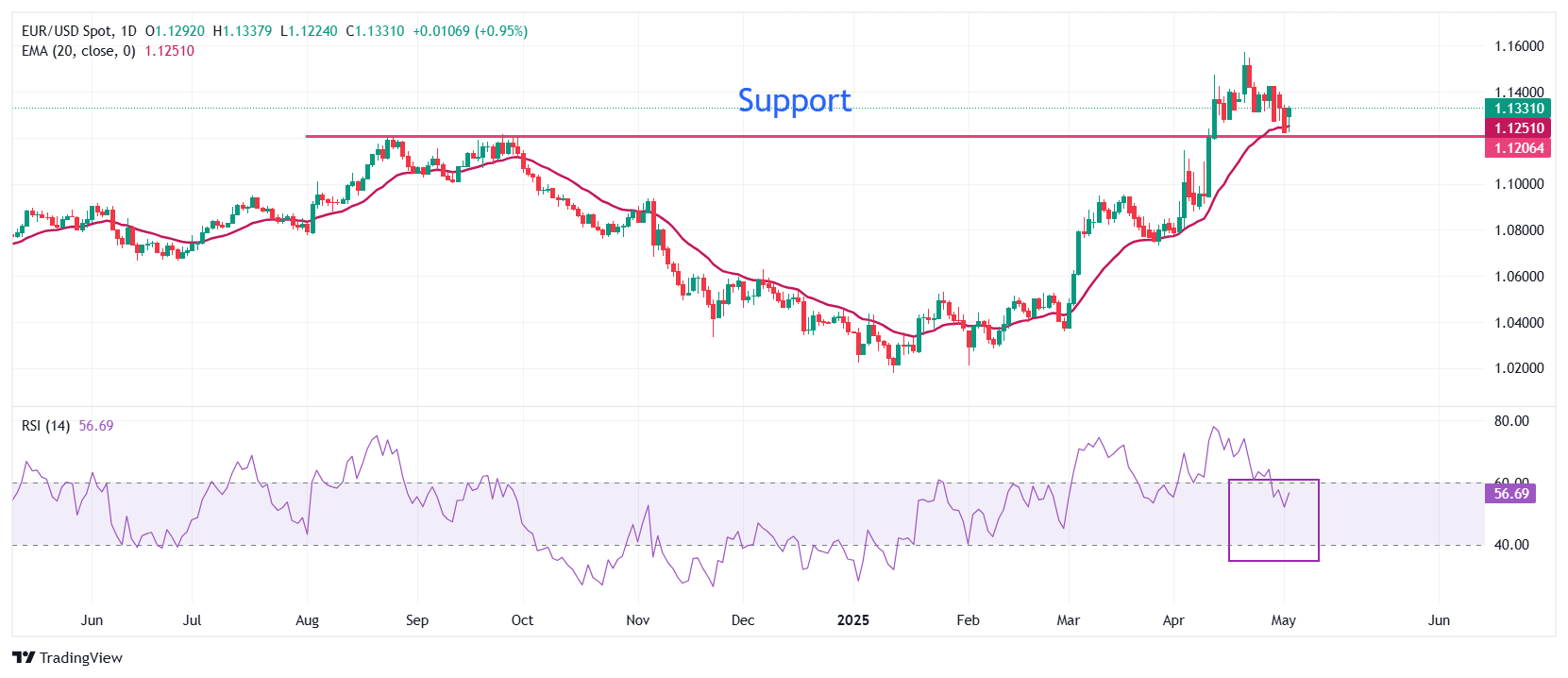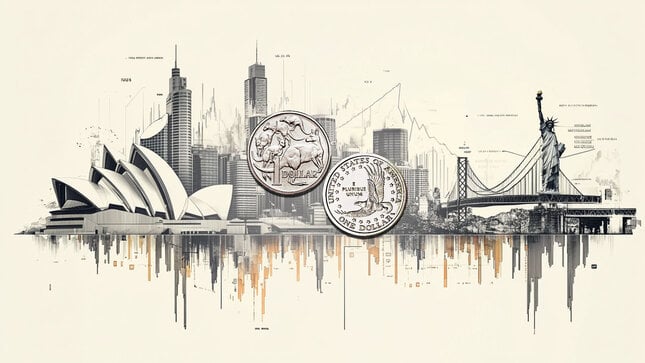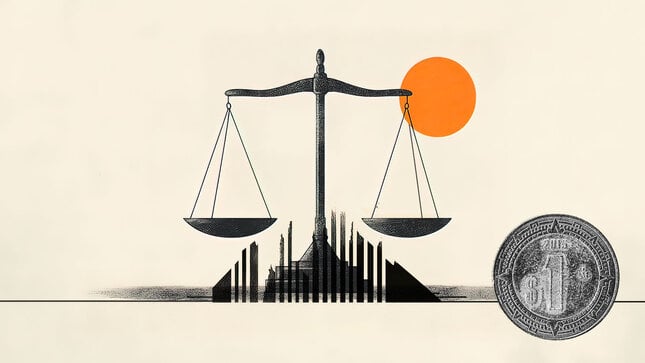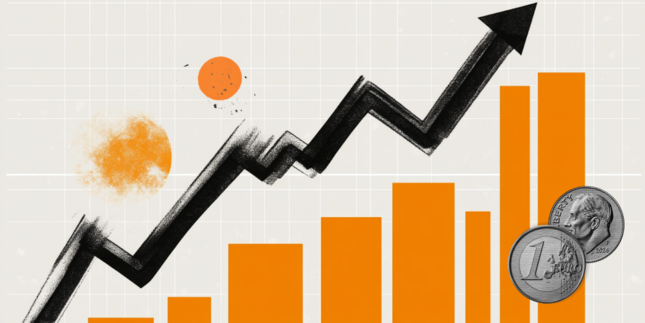EUR/USD surges after hot Eurozone HICP, upbeat US NFP data
- EUR/USD rallies to near 1.1380 as the US Dollar tumbles after US President Trump endorsed the need to lower interest rates.
- Flash Eurozone HICP shows that inflationary pressures grew at a faster-than-expected pace in April.
- The US NFP has shown an addition of 177K fresh workers, beating estimates of 130K.
EUR/USD extends initial gains to near 1.1380 in Friday’s North American session. The major currency advances as the US Dollar (USD) declines after United States (US) President Donald Trump insisted that the Federal Reserve (Fed) should lower interest rates. The US Dollar Index (DXY), which tracks the Greenback's value against six major currencies, tumbles below 99.50.
"Gasoline just broke $1.98 a Gallon, the lowest in years, groceries (and eggs!) down, energy down, mortgage rates down, employment strong, and much more good news, as Billions of Dollars pour in from Tariffs. Just like I said, and we’re only in a transition stage, just getting started!!! Consumers have been waiting for years to see pricing come down. No inflation, the Fed should lower its rate!!!," Trump wrote in a post on Truth.Social right after the release of the US Nonfarm Payrolls (NFP) data for April.
The NFP data showed that the US economy added 177K fresh workers, higher than estimates of 130K but slightly lower than the March reading of 185K, revised lower from 228K. The Unemployment Rate remains steady at 4.2%, as expected. Theoretically, upbeat job growth data despite elevated economic uncertainty due to the fallout of tariffs by US President Trump strengthens the case for keeping interest rates restrictive by the Fed in the near term. Upbeat NFP data has also forced traders to trim their bets supporting the Fed to cut interest rates in the June meeting.
According to the CME FedWatch tool, the probability for the Fed to reduce interest rates in June has dropped to 41% from 58% seen a day prior. In the May meeting, the central bank is almost certain to leave them unchanged in the range of 4.25%-4.50%.
Average Hourly Earnings data, a key measure of wage growth, rose moderately by 0.2% on month, compared to estimates and the prior release of 0.3%. Year-on-year, the wage growth measure grew steadily by 3.8%, slower than expectations of 3.9%.
Daily digest market movers: EUR/USD gains on hotter-than-expected Eurozone HICP data
- EUR/USD trades firmly after the release of the hotter-than-expected preliminary Eurozone Harmonized Index of Consumer Prices (HICP) data for April.
- The Eurostat reported that the core HICP – which excludes volatile components like food, energy, alcohol, and tobacco – grew at a faster pace of 2.7% compared to estimates of 2.5% and the March reading of 2.4%. In the same period, the headline HICP rose steadily by 2.2% on year, faster than estimates of 2.1%. Month-on-month, headline and core HICP rose steadily by 0.6% and 1.0%, respectively.
- The impact of the hot inflation figures is expected to be limited on market expectations for the European Central Bank’s (ECB) monetary policy outlook, as officials are more concerned about the economic slowdown in the face of additional tariffs imposed by US President Donald Trump. Regarding inflation, most ECB officials look confident that it will return to the central bank’s target of 2% this year, which has led traders to price in a 25 basis points (bps) interest rate reduction by the ECB in the June policy meeting.
- Earlier this week, ECB policymaker and Finnish central bank governor Olli Rehn supported the need for further monetary policy expansion and expressed concerns about deepening risks to Eurozone inflation undershooting the central bank’s target of 2% in the face of Trump’s tariffs. Rehn didn’t rule out the possibility of interest rates sliding below the neutral rate. "We must analyse all options with an open mind and not a priori rule out rate cuts below the neutral rate, Rehn said in an event, Reuters reported.
- Meanwhile, the US Dollar has slid further after Trump's post, but it was already underperforming its peers earlier in the day despite an increase in hopes of easing trade tensions between the US and China. Investors have become increasingly confident of a de-escalation in the Sino-US trade war after comments from the Chinese Commerce Ministry signaled their willingness to initiate trade talks with Washington.
- China says the door is open to trade talks and urged the US to demonstrate sincerity if it wants to negotiate, Bloomberg reported. From Washington, US President Donald Trump has also expressed confidence that the US will reach a deal with China. “There’s a very good chance we’re going to make a deal, but we’re going to make it on our terms,” Trump said in an interview at NewsNation Town Hall on Thursday, adding that the White House can “announce potential trade deals with South Korea, Japan, and India”.
- Technically, this scenario should have been favorable for the US Dollar as it diminishes fears of a decline in households’ purchasing power. Investors anticipated that US employers would pass on the burden of higher tariffs to customers, which would diminish their spending capacity.
Technical Analysis: EUR/USD aims to reclaim 1.1400

EUR/USD returns above the key level of 1.1300 on Friday after recovering from its two-week low of 1.1265 posted on Thursday and aims to recapture 1.1400. The major currency pair rebounded after attracting bids near the 20-day Exponential Moving Average (EMA) around 1.1260.
The 14-day Relative Strength Index (RSI) falls inside the 40.00-60.00 range, indicating that the bullish momentum is concluded for now. However, the upside bias still prevails.
Looking up, the psychological level of 1.1500 will be the major resistance for the pair. Conversely, the 25 September high of 1.1214 will be a key support for the Euro bulls.
(This story was corrected on May 2 at 10:16 GMT to say, in the first bullet and first paragraph, that the EUR/USD pair trades near 1.1300, not 1.3300. It was also corrected to say that analysts were expecting the Eurozone's HICP at 2.1%, not 2.2%.)
Fed FAQs
Monetary policy in the US is shaped by the Federal Reserve (Fed). The Fed has two mandates: to achieve price stability and foster full employment. Its primary tool to achieve these goals is by adjusting interest rates. When prices are rising too quickly and inflation is above the Fed’s 2% target, it raises interest rates, increasing borrowing costs throughout the economy. This results in a stronger US Dollar (USD) as it makes the US a more attractive place for international investors to park their money. When inflation falls below 2% or the Unemployment Rate is too high, the Fed may lower interest rates to encourage borrowing, which weighs on the Greenback.
The Federal Reserve (Fed) holds eight policy meetings a year, where the Federal Open Market Committee (FOMC) assesses economic conditions and makes monetary policy decisions. The FOMC is attended by twelve Fed officials – the seven members of the Board of Governors, the president of the Federal Reserve Bank of New York, and four of the remaining eleven regional Reserve Bank presidents, who serve one-year terms on a rotating basis.
In extreme situations, the Federal Reserve may resort to a policy named Quantitative Easing (QE). QE is the process by which the Fed substantially increases the flow of credit in a stuck financial system. It is a non-standard policy measure used during crises or when inflation is extremely low. It was the Fed’s weapon of choice during the Great Financial Crisis in 2008. It involves the Fed printing more Dollars and using them to buy high grade bonds from financial institutions. QE usually weakens the US Dollar.
Quantitative tightening (QT) is the reverse process of QE, whereby the Federal Reserve stops buying bonds from financial institutions and does not reinvest the principal from the bonds it holds maturing, to purchase new bonds. It is usually positive for the value of the US Dollar.
BRANDED CONTENT
If you're looking for the best brokers to trade the EUR/USD pair, explore our selected options. Knowing each broker’s strengths will help you find the ideal fit for your trading strategy.
Forex News
Keep up with the financial markets, know what's happening and what is affecting the markets with our latest market updates. Analyze market movers, trends and build your trading strategies accordingly.



















